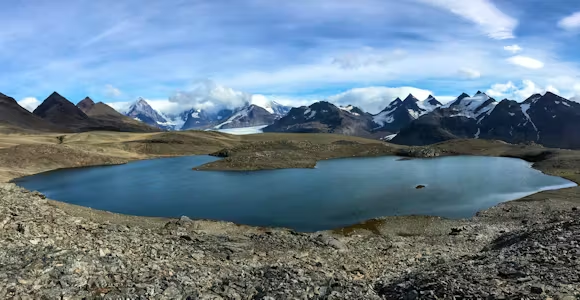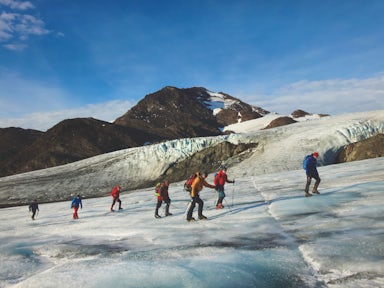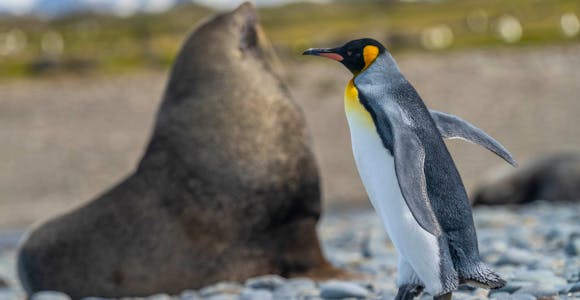
Fortuna Bay
Fortuna Bay is home to one of South Georgia's most charming king penguin colonies, and offers the chance to recreate the historic Shackleton Walk to Stromness.
Discover More
Glacier view at the head of King Haakon Bay
King Haakon Bay is an eight mile (13km) inlet on the western coast of South Georgia. It was named for the king of Norway in 1912 by Carl Anton Larsen, the founder of the whaling industry here. Nearly a dozen glaciers feed into the bay, although all are receding: climate change means that the tongue of only one still reaches directly into the sea.
Even during the time of whaling, no settlements were founded on the west coast of South Georgia due to its extreme exposure to the prevailing polar weather whipping up from the Scotia Sea. King Haakon Bay would remain unvisited to this day but one for one fact: it was here that the tiny James Caird landed in 1916 at the conclusion of Shackleton's dramatic voyage from Elephant Island to rescue the stranded crew of the Endurance, and was the starting point for his hike across the island to the whaling station at Stromness.
For this reason alone, King Haakon Bay is the only location on this side of the island visited today by expedition cruise ships – should the weather allow a visit to the west coast.
As well as Cape Rosa and Peggotty Bluff, visitors should keep their eyes open for McNish Island, on the northern approach to King Haakon Bay. It was christened in 1958 by the British Antarctic Survey in honour of the Endurance carpenter Henry McNish, who made the boat seaworthy as well as being part of the crew.

Shackleton's map of King Haakon Bay
After a 16 day voyage from Elephant Island, the six-man crew of the James Caird reached South Georgia, only to be met with near disaster when a vicious two day storm prevented them from landing and nearly sank the boat. On 8 May 1916 the exhausted and dehydrated men finally landed at landed at sheltered Cape Rosa on the southeastern tip of King Haakon Bay (called Cave Cove in Shackleton's account). By this time they were so weak they could hardly pull their boat ashore.
A cave provided shelter, made comfortable with beds of tussac grass and a diet of albatross chicks. A memorial plaque now marks their stay here. After four days recovering from their ordeal. Shackleton and his men sailed to the head of King Haakon Bay and made camp on the beach now known as Peggotty Bluff. The James Caird was overturned and turned into shelter.

Climbing the Fortuna Glacier on the Shackleton Crossing
On 18 May, Shackleton, Frank Worsley and Tom Crean set out to trek across the unmapped interior of the island to raise the alarm at one of the whaling stations. Their clothes were tattered; the only possible concession they could make to the icy conditions was to fix screws from the boat onto their boots for grip. After 30 hours of non-stop travel, finally blessed by good weather and full moon, they arrived at Stromness. The three men left at Peggotty Bluff who were in too poor a condition to attempt the hike – Tom Vincent, Henry 'Chippy' McNish and Timothy McCarthy – were rescued by a whaling ship the next day, in a hurricane that would have killed Shackleton, Worsley and Crean had it hit just hours earlier.
While many visitors to South Georgia happily hike the final stage of the Shackleton Walk (a 2.5 mile (4km) walk from Fortuna Bay to Stromness), it is also possible to recreate the full mountain journey. This is a truly once in a lifetime experience for those with sufficient alpine climbing and trekking experience. Knowledge of glacier travel techniques is mandatory, and all booking applications are reviewed by one of the climbing guides leading the group to assess suitability. If you'd like to know more, please get in touch.

Elephant seal pup in the tussac grass at Peggotty Bluff
Elephant seals proliferate along the northern shore of King Haakon Bay. It was their presence here that convinced Shackleton that they could overwinter here if the crossing of South Georgia proved impossible. As with elsewhere on the island, fur seals are also relatively recent colonisers.
Small numbers of King Penguins and gentoo penguins can often be seen at Peggotty Bluff. Giant petrels, brown skuas and kelp gulls nest in the tussac, and South Georgia pipits are seen and heard in increasing numbers. In Cape Rosa, there are large numbers of burrowing seabirds: common diving petrels, blue petrels and Antarctic prions. The nesting albatrosses that Shackleton's party so hungrily feasted on are no longer recorded here.
Price Match Promise - We’ll match any price you find elsewhere for the same trip
All visits to Cape Rosa must be made in accordance with the site visitor management plan produced by the Government of South Georgia & the South Sandwich Islands.
Landings at Cape Rosa are unpredictable at best: the narrow entrance to the cove makes approaches dangerous in all but the calmest conditions. No more than 20 people are allowed ashore at Cape Rosa at any one time, and visitors must not leave the beach area to prevent trampling of nesting seabird burrows.
The beach at Peggotty Bluff at the head of King Haakon Bay is more sheltered, making landings more likely if your ship has been able to navigate the western coast. From the beach it is possible to to walk through the tussac to the edge of the Murray snowfield, from where Shackleton, Worsley and Crean began their hike.
NOTE: Ship itineraries and visits to specific landing sites in South Georgia can never be guaranteed. Plans can change as fast as the polar weather: decisions on which locations to visit are always made on the day by the ship's captain and expedition leader.

Fortuna Bay is home to one of South Georgia's most charming king penguin colonies, and offers the chance to recreate the historic Shackleton Walk to Stromness.
Discover More
Raise a toast to Shackleton and walk around the rusting ruins of the old whaling station at Grytviken, the historic heart of South Georgia.
Discover More
With its amphitheatre-like mountains and large numbers of king penguins and elephant and fur seals, Salisbury Plain is as truly jaw-dropping as South Georgia gets.
Discover More
Godthul offers three key South Georgia experiences in one location: penguins, a brush with its whaling history and hiking into the hills for arresting views.
Discover MoreWe'll spend some time listening to your aspirations, then discuss the kind of experience that might suit you.
Next we'll discuss the options, shortlist the best trips for you and present you our impartial recommendations.
We'll place a 24 hour hold on your preferred option - without obligation - whilst we talk through the details.